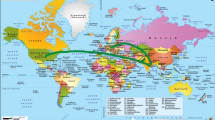Abstract
Ethnopharmacology, the study of ethnic use of drugs, opens up the crucial gateway to understanding and promoting traditional medicine in the new age. Taiwan is a unique region where traditional medicine and herbal therapeutics have been benefiting its people of multiple races for centuries. This article overviews Taiwan’s indigenous traditional medicine and the emerging status of ethnopharmacology study, and outlines the global scenario of the inheritance and development of traditional medicine. In such a scope of knowledge protection, this article particularly highlights the challenges with bioprospecting and biopiracy, and summarizes the current measures for protection of traditional knowledge in Taiwan. Finally, based upon these analyses, we propose rational strategies for promoting Taiwan’s ethnopharmacology, from multiple angles of resource, economy, policy and law. We conclude that four measures, namely (1) protecting the natural environment of biodiversity, (2) avoiding unnecessary conflicts caused by bioprospecting and biopiracy, (3) strengthening the international collaboration, and (4) upgrading the legal system of traditional intelligence, would be the right paths for Taiwan to protect its invaluable heritage of traditional medicine and the knowledge of ethnopharmacology therein.
Similar content being viewed by others
References
Reyes-Garcia V. The relevance of traditional knowledge systems for ethnopharmacological research: theoretical and methodological contributions. J Ethnobiol Ethnomed 2010;6:32–36.
Xu H, Chen KJ. Complementary and alternative medicine: is it possible to be mainstream? Chin J Integr Med 2012;18:403–404.
Dutfield G. Protecting traditional knowledge: pathways to the future. ICTSD Prog IPR Sust Dev 2006;3–4.
Tsai C. Traditional knowledge protection of indigenous people. Taiwan Indig Stud Rev 2007;2:1–26.
Tong Y, He W, Zhao Y. World Health Organization Traditional Medicine Policy Review. Chin J Inf Tradit Chin Med (Chin) 2010;17:2–3.
Wang JH. Traditional Chinese medicine and the positive correlation with homeostatic evolution of human being: based on medical perspective. Chin J Integr Med 2012;18:629–634.
Tian P. Convergence: where West meets East. Nature 2011;480:84–86.
Nalawade SM, Sagare AP, Lee CY, Kao CL, Tsay HS. Studies on tissue culture of Chinese medicinal plant resources in Taiwan and their sustainable utilization. Bot Bull Acad Sin 2003;44:79–98.
Namba T. Current research on traditional medicines and an introduction of ethnopharmacology. J Chin Med 1996;7:59–72.
Xue TH. Trusting in traditional cures. Nature 1996;379:110.
Liang M, Liu Y, Ananda S, Zhuo L, Liu L. Toxicology of Dysosma versipallis rhizome: a review. J Med Plant Res 2010;4:717–721.
Ranilla LG, Kwon YI, Apostolidis E, Shetty K. Phenolic compounds, antioxidant activity and in vitro inhibitory potential against key enzymes relevant for hyperglycemia and hypertension of commonly used medicinal plants, herbs and spices in Latin America. Bioresour Technol 2010;101:4676–4689.
Ham I, Lee SJ, Kim H, Kang IH, Jin HO, Whang WK. Standardization and seasonal variation of quercetin glycoside in Eucommiae folium. Kor J Pharmacog 2002;33:194–199.
Elly D. A Chinese herbal formula for relief of asthma? Focus Altern Complement Ther 2005;10:189–191.
Tamaki A, Ide T, Otsuka H. Phenolic glycosides from the leaves of Alangium platanifolium var. platanifolium. J Nat Prod 2000;63:1417–1419.
Shen YX, Teng HL, Yang GZ, Mei ZN, Chen XL. A new chromone derivative from Berchemia lineate. Acta Pharm Sin 2010;45:1139–1143.
Broughton A. An overview of Yellow Card reporting by NIMH practitioners. J Herb Med 2011;1:15–29.
Heinrich M, Chan J, Wanke S, Neinhuis C, Simmonds M. Local uses of Aristolochia species and content of nephrotoxic aristolochic acid 1 and 2—a global assessment based on bibliographic sources. J Ethnopharmacol 2009;125:108–144.
Sharma HK, Kumar A. Evaluation of total phenol, flavonoid and in vitro antioxidant activity of methanolic extract of leaves of Melastoma malabathricum linn. Asian J Chem 2011;23:434–438.
Pieroni A, Dibra B, Grishaj G, Grishaj I, Maçai SG. Traditional phytotherapy of the Albanians of Lepushe, Northern Albanian Alps. Fitoterapia 2005;76:379–399.
Ho SC, Ho YF, Lai TH, Liu TH, Su SY, Wu RY. Effect of Tianma Gouteng Decoction with subtractive ingredients and its active constituents on memory acquisition. Am J Chin Med 2008;36:593–602.
Sun Q, Shao FX, Li JJ, Wang J, Kou JP, Yu BY. Advances in studies on active components modulating tissue factor in Chinese materia medica. Chin Tradit Herb Drugs (Chin) 2010;41:488–491.
Cheung F. Traditional Chinese medicine: made in China. Nature 2011;480:82–83.
Castree N. Bioprospecting: from theory to practice (and back again). Trans Inst Br Geogr 2003;28:35–55.
Greene S. Indigenous people incorporated? Culture as politics, culture as property in pharmaceutical bioprospecting. Curr Anthropol 2004;45:211–237.
Kuo WHJ. A preliminary study on the protection of traditional knowledge. Tsing Hua J Law Technol Policy 2005;2:49–99.
Allred BB, Park WG. Patent rights and innovative activity: evidence from national and firm-level data. J Int Business Stud 2007;38:878–900.
Tang L. Patent status of Chinese medicinal herb in foreign countries and registered patents in China by foreigners. Sci Technol Manage Res (Chin) 2010;176–180.
Reid J. Biopiracy: the struggle for traditional knowledge rights. Am Ind Law Rev 2009;34:77–98.
Chowdhury N. Patents bill: protecting indigenous knowledge. Eco Politic Weekly 2004;39:4984–4986.
Tedlock B. Indigenous heritage and biopiracy in the age of intellectual property rights. Explore 2006;2:256–259.
Wang T, Che M, Wang Y. Cases study on international traditional medical knowledge rights protection. Chin J New Drugs (Chin) 2006;15:1609–1614.
Deardorff A. Welfare effects of global patent protection. Economeica 1992;59:36–51.
Diwan I, Rodrik D. Patents, appropriate technology, and North-South trade. J Int Economics 1991;30:27–48.
Blaustein R. Genetic resources and the convention on biological diversity. Bio Sci 2006;56:560–563.
Roopnaraine T. Indigenous knowledge, biodiversity and rights. Anthropol Today 1998;14:16.
http://seed.agron.ntu.edu.tw/agra/indilaw.htm (retrieved on 2013-03-14).
Lee JH, Lee DH, Choi BH. Phylogeography and genetic diversity of East Asian Neolitsea sericea (Lauraceae) based on variations in chloroplast DNA sequences. J Plant Res 2013;126:193–202.
Liang BA. Global governance: promoting biodiversity and protecting indigenous communities against biopiracy. J Commerc Biotechnol 2011;17:248–253.
Yen SY. Legal protection of Chinese herbal medicine. Tunghai Law Rev 2005;23:251–296.
Author information
Authors and Affiliations
Corresponding author
Additional information
Co-first authors
Rights and permissions
About this article
Cite this article
Guo, Jj., Pan, W., Chen, Mw. et al. Overview of Taiwan’s indigenous ethnopharmacology in the perspective of traditional knowledge protection. Chin. J. Integr. Med. 21, 949–954 (2015). https://doi.org/10.1007/s11655-013-1339-9
Received:
Published:
Issue Date:
DOI: https://doi.org/10.1007/s11655-013-1339-9



